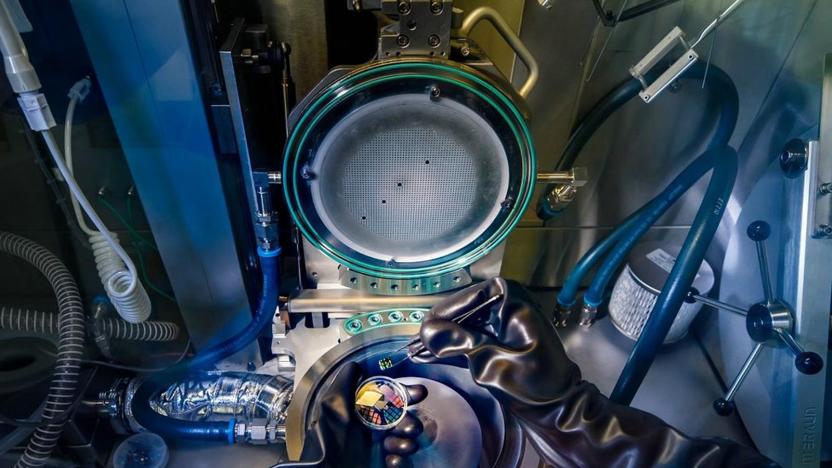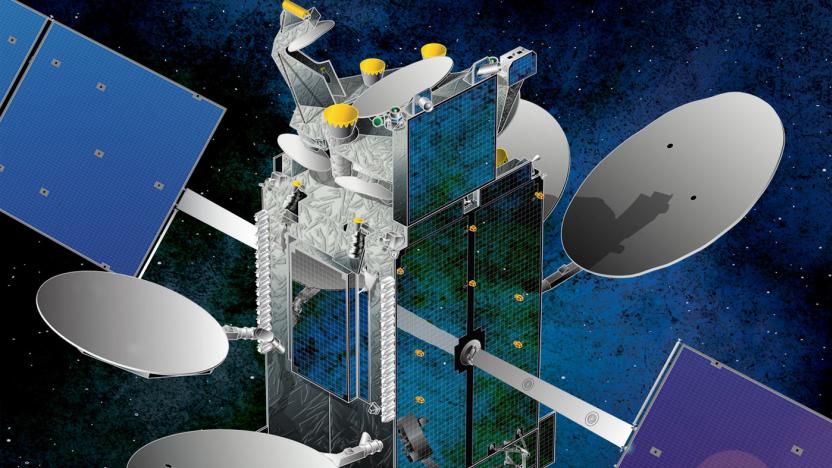photonics
Latest

Light-emitting silicon overcomes a major obstacle to denser, faster chips
Light-emitting silicon nanowires are finally a reality, opening the door to a new wave of denser and faster chips.

Color-changing smart skin gets an upgrade thanks to chameleons
Color-changing smart skin is nothing new, but scientists have had a hard time working out the kinks. Current smart skin is fragile and buckles after being exposed to varying temperatures. To help remedy that problem, scientists turned to analyzing detailed videos of chameleons' skin. This helped them develop a far more resilient take on this tech, which shows a more promising future for color-changing gear.

Holographic tech could be key to future quantum computers
A breakthrough in studying light might just be the ticket to the future of quantum computing. Researchers at EPFL have found a way to determine how light behaves beyond the limitations of wavelengths, opening the door to encoding quantum data in a sci-fi style holographic light pattern. The team took advantage of the quantum nature of the interaction between electrons and light to separate beams in terms energy, not space -- that let them use light pulses to encrypt info on the electron wave and map it with a speedy electron microscope.

Twisted light could make wireless data faster than fiber
As fast as fiber optic lines have become, they're still hamstrung by one key limitation: you still need to transmit that data over wires, which limits where you can transmit and the affordability of the fastest connections. Scientists may have a way to eliminate those cables while offering even faster speeds, though. They've discovered a way to 'twist' photons in a way that not only crams more data into each transmission, but survives interference from turbulent air. If you pass light through a special hologram, you can give photons an optical angular momentum that lets them carry more than just 1s and 0s -- and so long as the light's phase and intensity are right, you can reliably beam that data over long distances.

Lockheed Martin previews a future of tiny space telescopes
Current space telescopes are... big. You can't really avoid it given the need for giant lenses and bulky sensors. Lockheed Martin wants to fix that -- the aerospace firm has just released the first images from SPIDER (Segmented Planar Imaging Detector for Electro-Optical Reconnaissance), an optical instrument that promises pictures as sharp as what you'd get from a space telescope in a sensor that's just an inch thick. Instead of using a handful of monolithic lenses, it relies on a legion of small lenses whose data is divided and recombined using a photonic circuit. The initial results aren't spectacular, but they hold a lot of promise.

Super-fast camera records light-based 'sonic booms'
Scientists have suspected that light can create its own conical wakes, like a sonic boom, but how do you capture something that happens so quickly? With a very fast camera, naturally. Washington University in St. Louis has recorded these photonic shockwaves using a "streak camera" that measures both the image and temporal data at 100 billion frames per second. To visualize the cones, the team shot very fast green laser pulses (just 7 picoseconds long) through a tunnel full of dry fog and placed between plates made from aluminum oxide and silicone rubber. Since the laser moved faster in the tunnel than in the plates, it produced a sonic boom-like effect as some of the light dragged behind.

HP successfully tests its vision of memory-focused computing
HP's grand dream for the future of computing, The Machine, is no longer just a set of clever ideas and hardware research. Hewlett Packard Enterprise (the business-focused company that emerged from HP's split) has successfully tested its Memory-Driven Computing architecture, where memory is more important to completing tasks than raw processing power. It's just a proof-of-concept prototype, but it shows that everything works: compute nodes that share a pool of fast but permanent memory, speedy photonics-based data links and the custom software needed to make it all run.

Light-based neural network could lead to super-fast AI
It's one thing to create computers that behave like brains, but it's something else to make them perform as well as brains. Conventional circuitry can only operate so quickly as part of a neural network, even if it's sometimes much more powerful than standard computers. However, Princeton researchers might have smashed that barrier: they've built what they say is the first photonic neural network. The system mimics the brain with "neurons" that are really light waveguides cut into silicon substrates. As each of those nodes operates in a specific wavelength, you can make calculations by summing up the total power of the light as it's fed into a laser -- and the laser completes the circuit by sending light back to the nodes. The result is a machine that can calculate a differential math equation 1,960 times faster than a typical processor.

NASA is making a data modem driven by light
Now that photonic (that is, light-based) chips are a practical reality, they're going to get their ultimate test: space. NASA is developing an integrated photonics modem that will be used to test high-speed laser communications between Earth and spacecraft that are in low and geosynchronous orbits. And unlike the LADEE laser data test from 2013, this is very much intended for practical use -- the Laser Communications Relay Demonstration (LCRD) should be fully operational two years after its initial deployment.

Researchers show off a working light-based processor
The year has been chock-full of scientific breakthroughs, but the University of Colorado is determined to finish 2015 with a bang. Its researchers have created what they say is the first full-fledged processor to transmit data using light instead of electricity. The design isn't entirely photonic, but its 850 optical input/output elements give it the kind of bandwidth that make electric-only chips look downright modest -- we're talking 300Gbps per square millimeter, or 10 to 50 times what you normally see. The key was finding a way to reuse existing conventional processes to put optics in places where regular circuitry would go.

First light-based memory chip puts SSDs on notice
Researchers have created the first optical-only chip that can permanently store data, a discovery that could lead to storage devices that leave SSDs in the dust. Non-volatile flash memory currently relies on electronic chips, which are speed-limited by the heat and resistance generated by colliding electrons. Light-based circuits don't have that problem, but so far "nano-photonic" chips created by the likes of IBM are volatile (need to be powered), making them a non-option for permanent storage. The team from Oxford and the Karlsruhe Institute of Technology in Germany managed to solve that problem using a familiar light-based storage medium: DVDs.

Researchers inject oil into cells and create little lasers
The Massachusetts General Hospital research team that lit up human cells with the help of jellyfish genes a few years ago are back with a more advanced version of the technology. This new version forgoes the complicated external mirror setup in favor of injectable oil droplets impregnated with fluorescent dye. This is the same basic idea as what a team from St Andrews University recently created, except that the plastic bead that served as the their laser's resonating chamber is now an oil droplet. While the technology isn't ready for therapeutic applications just yet, it does hold a great deal of promise. The problem with conventional cellular markers and dye is that they have a broad emission spectrum which can make it difficult to spot the marked cells amidst the rest of the tissue. But with these miniature lasers, doctors will be able to mark and track individual cells no matter where they are in the body. The team recently published their findings in Nature Photonics.

Basics of quantum teleportation now fit on a single chip
Until now, quantum teleportation (that is, sending quantum data from one place to another) has required a room-filling machine. That's not going to usher in a brave new era of quantum computing, is it? However, a team of British and Japanese researchers has shrunk things down to a much more reasonable size. They've stuffed the core optical circuits for quantum teleportation into a single silicon chip that's just slightly longer than a penny -- in contrast, an experimental device from 2013 was nearly 14 feet long. While scientists built the chip using "state-of-the-art nano-fabrication," it should be more practical to make than its ancestors, which took months.

Entangled photons on a chip could lead to super-fast computers
Photon entanglement is one of the odder properties of quantum physics, but it promises a lot for computing -- if one photon can instantly affect another no matter how far away it is, you could make super-speedy computers and communications that aren't easily limited by physical distances. It hasn't been easy to get entanglement tech down to a manageable size, however, and that's where Italy's Università degli Studi di Pavia might just come to the rescue. Its researchers have developed a tiny emitter that could pump out entangled photons as part of an otherwise ordinary silicon chip. The device, which uses a ring shape to both rope in and emit light, measures just 20 microns across. That's hundreds of times smaller than existing devices, which are comparatively gigantic at a few millimeters wide.

Light-bending silicon strips are the key to super-fast computers
No, that's not a barcode you're looking at -- instead, it's the likely future of computing. Stanford University researchers have developed an optical link that uses silicon strips to bend light at right angles, which future processors will likely need to transmit data at super-fast speeds. The key, as you might have gathered, is the series of gaps. When light hits the device, the combination of those gaps and silicon sends different wavelengths left and right. You're not limited to specific light bands or directions, either; you can use an algorithm to design the link you need within a matter of minutes.

Future phones will have security measures built into the glass
The glass on your smartphone screen doesn't do a lot right now: it lets pictures and touch input get through, and that's about it. It may pick up a few extra talents in the future, though. Researchers at Polytechnique Montreal have developed sensors that can sit under the surface of the scratch-resistant Gorilla Glass used in many mobile devices. Their approach etches optical waveguides into the display, letting it track changes in light. As a result, the screen can do things that would normally require either wiring or dedicated sensors. Your phone could check its temperature using light, and the manufacturer could even embed a unique optical pattern into the glass that lets the phone identify itself; it might get much harder to clone a device (and, presumably, its information).

HP's Machine technology rethinks the basics of computing
We've seen bits and pieces of technology that hint at the future of computing, but HP has just taken a big, big step toward bringing them all together. The company has unveiled The Machine (yes, that's the name), a processing architecture designed to cope with the flood of data from an internet of things. It uses clusters of special-purpose cores, rather than a few generalized cores; photonics link everything instead of slow, energy-hungry copper wires; memristors give it unified memory that's as fast as RAM yet stores data permanently, like a flash drive.

Scientists find a way to create matter from light
Scientists have long theorized that you can create matter from light by colliding photons, but proving that theory has been a different story -- you need the right high-energy particles to even think of trying. However, it looks like that once-impossible dream is close to becoming reality. Researchers at Imperial College London have discovered a technique that should produce electrons and positrons by colliding two sets of super-energetic photons. To create the first batch of photons, you have to first blast electrons with a laser, and then shoot them at a piece of gold; you produce the other batch by firing a laser at the inside of a small gold can to produce a thermal radiation field. If you collide the two photon sources inside the can, you should see electrons and positrons spilling out.

Facebook's Open Compute Project splits up monolithic servers with help from Intel, more
As much as it's important to have every component of a PC stuck together in a laptop, that same monolithic strategy is a major liability for server clusters: if one part breaks or grows obsolete, it can drag down everything else. Facebook and its Open Compute Project partners have just unveiled plans to loosen things up at the datacenter. A prototype, Atom-based rackmount server from Quanta Computer uses 100Gbps silicon photonics from Intel to connect parts at full speed, anywhere on the rack. Facebook has also garnered support for a new system-on-chip connection standard, rather affectionately named Group Hug, that would let owners swap in new mini systems from any vendor through PCI Express cards. The combined effect doesn't just simplify repairs and upgrades -- it lets companies build the exact servers they need without having to scrap other crucial elements in the process. There's no definite timeframe for when we'll see modular servers put to work, but the hope is that a cluster's foundations will stay relevant for years instead of months.

Caltech laser accelerometer research may bring fine-tuned position tracking, grocery ads
One way that sensors can track your position without using an array of satellites is by measuring your acceleration as you move around -- but unless you're piloting a jumbo jet, current devices aren't very accurate. Researchers at Caltech hope to change all that with a new, ultra-sensitive accelerometer they developed, which uses laser light to detect motion changes. The scientists managed to shrink a so-called large-scale interferometer down to micro-scale sizes, creating a device "thousands of times faster than the most sensitive sensors used today." That could allow a smartphone with such a micro-sensor to detect your exact position even while inside a grocery store, and flash "ads and coupons for hot dog buns" while you're in the bread aisle, according to Caltech. All that sounds good, but we can perhaps think of more inspiring uses for the new tech.



